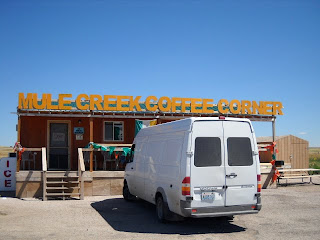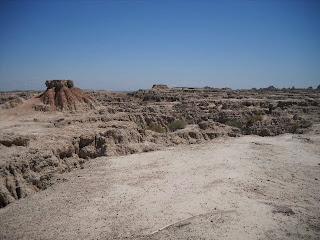




Our original itinerary included 1.5 days at Mesa Verde, but after 5 days we’re still here! We are both addicted to looking for cliff dwellings during hikes and drives and we wanted to make sure we saw all the ruins open to the public. So, we’ve spent the past 5 days exploring. We start our days at the pancake breakfast in the café, we tour/hike in the morning, we make sandwiches for lunch in the Sprinter, we tour/hike in the afternoon, and we make our way back to camp for dinner and a ranger talk before going to bed very exhausted, but excited about another day of touring. From the campground (a few miles inside the park), the mesas (3 main ones) that are home to the ruins are about a 30-minute drive up winding, hill-climbing roads that are under construction in several areas. We always head up the hill early to beat traffic and construction. On Thursday, we toured Long House, the second largest cliff dwelling at Mesa Verde, which is only accessible via tram and then a hike down into the alcove. We then toured all of the dwellings near Long House, which included taking 2 short hikes in the blazing hot sun! Because we’re mostly hiking over bumpy trails of sandstone, there are many crevices for critters to hide in. We are thankful we’ve only seen two snakes…mostly lizards and crazy grasshopper-like things that are all over the place (again…just like the Badlands!). We have become dwelling detectives in this park. We are constantly searching for dwellings and our binoculars are always ready (to look across the canyons)! After this many days in the park, we have learned so much from the literature, artifacts in the museum, ranger-guided hikes, ranger-guided dwelling tours, and nightly fireside ranger programs to know what to look for. We can easily determine if rooms were used for storage, ceremonies, food preparation, or sleeping and we can spot different periods of construction and hand and toe trails (how they went up and down the cliffs) from anywhere. The rangers even know us now! On Thursday night we took a Twilight Tour of Cliff Palace. These tours are the last tour of the day, led by a ranger in character, from the perspective of someone who was influential in Mesa Verde’s past. Our tour was told from the perspective of Al Wetherill, one of the brothers who discovered Cliff Palace while herding cattle. It was fascinating and so amazing to experience Cliff Palace at sunset. The next morning, we were back on the mesa tops for an early morning hike. On these early morning drives, we always see grazing deer and their fawns and some of the 100 wild horses that call this park their home. This hike was led by a ranger and toured a dwelling otherwise inaccessible by the public. It was another large dwelling, home to 80-100 people, and we enjoyed the adventurous hike up and down the mountain. This was a small group and we had the pleasure of meeting a member of a nearby Apache tribe. He was on the Mug House hike as a tourist, and he shared a lot of information with us. He has been a tribal lawyer/judge for the last 25 years and he was instrumental in writing/passing the legislation for NAGPRA (Native American Graves Protection and Repatriation Act). It was very interesting to hear his perspective and he even showed us the beginning steps of weaving yucca fibers to make sandals, rope, etc. From here, we went to the museum (again) and watched the intro movie, looked at artifacts, and Deven went through the process to earn her Junior Ranger badge. This is a little bit of a challenging process, but a great way to educate kids about the park; recommended for ages 5-11, but Deven’s been dying to do it since our first park! She had to answer questions about the park, complete an information booklet, and be sworn in by an official ranger. The hardest part of the whole thing was when the ranger’s final question was, “and do you promise to keep your room clean?” I think she lied and said she would! Anyway, she finally earned her badge and is an official Mesa Verde Junior Park Ranger! To celebrate, we toured another mesa top covered in dwellings then headed back to camp for dinner and the ranger talk. This morning (Saturday), we had our final day at Mesa Verde. After our final pancake breakfast, we headed up the hill to tour the few sights we haven’t yet seen. We started on our self-guided tour of Spruce Tree House, the best-preserved dwelling in the park. We then headed out on a hike to see the largest collection of petroglyphs in the park. A few yards into our hike, it started pouring and thunder and lightning were quickly approaching the canyon. We both really wanted to go so we ran back to the car for our raingear and headed out on our 2-hour hike. It was pouring the entire time and we had to scramble over boulders, make our way in the slippery mud, squeeze between large slabs of sandstone, and remember to stay below timberline. Along the path, we saw a few other dwellings and many spectacular cross-canyon views. Eventually, we saw the petroglyphs and as we climbed back up to the mesa top, it finally stopped raining. We were soaked and tired, but had so much fun – and we both agreed that the hike would’ve been miserable in the hot days we’ve had for the past week. We made our way back to the campground, rode the scooter to do laundry, made a yummy dinner and sat by the campfire looking at the stars. We will miss this place – but we’re off to more park sprinting early tomorrow morning!
















































